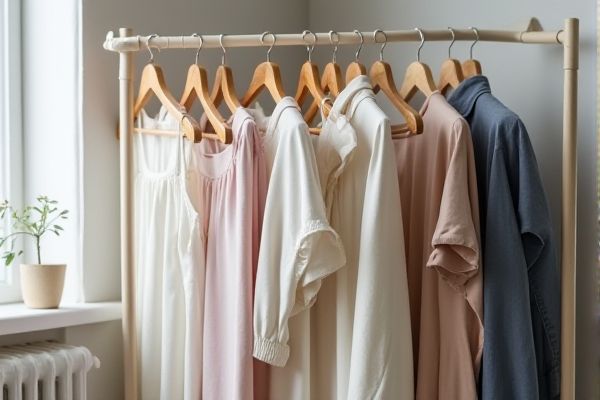
Tension rods offer a flexible, damage-free solution for hanging clothes, easily adjusting to fit various spaces without drilling, while permanent rods provide a more durable, stable option ideal for heavy loads or long-term use. Discover which rod best suits your clothing-hanging needs by reading the rest of this article.
Table of Comparison
| Feature | Tension Rod | Permanent Rod |
|---|---|---|
| Installation | No drilling required; quick setup | Requires drilling and mounting hardware |
| Stability | Moderate; relies on tension pressure | High; fixed securely to wall |
| Weight Capacity | Up to 20-30 lbs (9-14 kg) | Up to 50+ lbs (22+ kg) depending on materials |
| Flexibility | Adjustable length; easy to move | Fixed length; permanent placement |
| Wall Damage | None; no holes needed | Yes; leaves holes after removal |
| Ideal Use | Temporary hanging, low to medium weight | Long-term, heavy-duty hanging |
| Cost | Lower; typically under $20 | Higher; depends on materials and installation |
Introduction to Tension Rods and Permanent Rods
Tension rods are adjustable, easy-to-install rods that use spring tension to hold themselves securely between two surfaces without drilling, making them ideal for temporary or renter-friendly clothing hanging solutions. Permanent rods require fixed installation through screws or brackets and offer greater stability and weight capacity for long-term use in closets or laundry rooms. Your choice depends on whether you prioritize flexibility and ease of setup or durability and maximum load-bearing strength.
Key Differences Between Tension and Permanent Rods
Tension rods rely on adjustable spring mechanisms to stay in place without hardware, making them ideal for temporary or rental settings where damage to walls is a concern. Permanent rods require brackets and screws for secure mounting, offering greater stability and weight capacity suitable for heavy clothing loads. Tension rods are easier to install and reposition but may slip under heavy weight, while permanent rods provide durability and long-term support for hanging clothes.
Installation Process: Tension Rod vs Permanent Rod
Tension rods require no drilling and use adjustable pressure to fit securely between two walls, making installation quick and tool-free. Permanent rods need mounting brackets fixed with screws, demanding precise measurements and wall anchors to ensure stability over time. You benefit from tension rods' easy setup and flexibility, while permanent rods offer a more robust, lasting solution for hanging clothes.
Durability and Weight Capacity Comparison
Tension rods rely on adjustable spring mechanisms and rubber grips, offering moderate durability but typically supporting lighter weight loads, generally up to 20-30 pounds. Permanent rods, often made from solid metal or heavy-duty steel, provide superior durability and can support significantly heavier weights, frequently exceeding 50 pounds. Choosing a permanent rod ensures long-term reliability and high weight capacity for hanging clothes, especially in closets or laundry areas with frequent use.
Suitability for Different Spaces and Uses
Tension rods offer versatility for temporary hanging solutions, making them ideal for renters or small spaces where drilling is not permitted, as they use adjustable spring-loaded mechanisms to fit various widths without damage. Permanent rods, typically made from sturdy materials like metal or wood, provide robust support for heavy clothing and long-term installation in closets or laundry rooms, ensuring maximum durability and stability. Choosing between tension and permanent rods depends on space size, installation preferences, and the weight of clothes to be hung.
Aesthetic Appeal and Design Options
Tension rods offer a sleek, minimalistic look that blends seamlessly into various room styles, making them ideal for temporary hanging solutions without damaging walls. Permanent rods provide a more robust and customizable design, allowing for decorative brackets, finishes, and shapes that enhance the overall aesthetic of your space. Your choice will depend on whether you prioritize flexibility and ease of installation or long-term design integration.
Cost and Budget Considerations
Tension rods typically offer a cost-effective and budget-friendly solution for hanging clothes due to their affordable price and easy DIY installation. Permanent rods, while more expensive upfront, provide greater durability and stability, making them a worthwhile investment for long-term use and heavy garments. Your choice should balance initial cost against longevity and usage needs to optimize value in your wardrobe organization.
Flexibility and Ease of Adjustment
Tension rods offer exceptional flexibility and ease of adjustment, allowing you to quickly customize the length and fit without tools, making them ideal for temporary or frequently changing spaces. Permanent rods require installation with brackets or screws, providing sturdy support but limiting adjustability once fixed. For hanging clothes in dynamic environments, tension rods provide more convenience and adaptability compared to permanent rods.
Maintenance and Longevity
Tension rods require minimal maintenance as they can be easily adjusted or removed without causing damage to walls, but their longevity may be limited by the quality of the spring mechanism and frequent adjustments. Permanent rods, typically mounted with brackets, offer greater durability and stability for hanging clothes long-term, though they may involve occasional tightening of screws or repainting to prevent rust and wear. Choosing between these options depends on the balance between ease of upkeep and the desired durability in a fixed closet or laundry setup.
Which Rod Is Best for Hanging Clothes?
Tension rods offer easy installation and adjustability, making them ideal for temporary or lightweight clothes hanging in closets or laundry rooms. Permanent rods, typically made of sturdy metal or wood and securely mounted, provide greater durability and support for heavier garments or long-term use. For hanging clothes reliably over time, permanent rods are generally the best choice due to their strength and stability.
 homyna.com
homyna.com